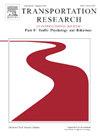Who wants to use transport super apps? Insights from combined PLS-SEM and NCA methods
IF 3.5
2区 工程技术
Q1 PSYCHOLOGY, APPLIED
Transportation Research Part F-Traffic Psychology and Behaviour
Pub Date : 2025-04-28
DOI:10.1016/j.trf.2025.04.018
引用次数: 0
Abstract
Super apps are a recent phenomenon in the retail sector, seamlessly integrating mobility, delivery, payments, entertainment, and other services into a single platform. While super apps such as WeChat and Alipay are well-established in many Asian markets, their adoption in Western markets remains largely underexplored. This study addresses this gap by examining consumer intentions to adopt transport super apps in Germany, where platforms like Uber and Bolt are beginning to introduce the super app concept. Combining Partial Least Squares Structural Equation Modeling (PLS-SEM) and Necessary Condition Analysis (NCA), data from 575 potential users were analyzed. The results reveal that performance expectancy (PE), price value (PV), and habit (HA) significantly impact behavioral intentions to use transport super apps. Notably, PE and PV are necessary conditions for consumer adoption to manifest. Achieving the highest level of adoption intention requires meeting minimum threshold levels of 35.6% for PE and 12% for PV. Moreover, “app fatigue” was found to positively influence adoption, suggesting that super apps are perceived as convenient replacements for multiple single-purpose apps. The insights from this study highlight the importance of tailoring marketing strategies to emphasize transport super apps’ valued benefits for key target groups. This research contributes to the emerging literature on super apps, highlighting the need for sector-specific investigations across various super app categories.
谁想使用交通超级应用程序?结合PLS-SEM和NCA方法的见解
超级应用是零售领域最近出现的一种现象,它将移动、配送、支付、娱乐和其他服务无缝集成到一个平台上。虽然b微信和支付宝等超级应用在许多亚洲市场都很成熟,但它们在西方市场的应用仍未得到充分开发。这项研究通过调查德国消费者采用超级交通应用程序的意愿来解决这一差距,在德国,Uber和Bolt等平台开始引入超级应用程序概念。结合偏最小二乘结构方程模型(PLS-SEM)和必要条件分析(NCA),对575名潜在用户的数据进行了分析。结果表明,性能期望(PE)、价格价值(PV)和习惯(HA)显著影响使用运输超级应用程序的行为意图。值得注意的是,PE和PV是消费者采用的必要条件。要达到最高水平的采用意愿,需要达到PE的35.6%和PV的12%的最低门槛水平。此外,“应用疲劳”被发现对应用产生积极影响,这表明超级应用被认为是多个单一用途应用的方便替代品。这项研究的见解强调了定制营销策略的重要性,以强调运输超级应用程序对关键目标群体的价值效益。这项研究为超级应用的新兴文献做出了贡献,强调了对各种超级应用类别进行特定行业调查的必要性。
本文章由计算机程序翻译,如有差异,请以英文原文为准。
求助全文
约1分钟内获得全文
求助全文
来源期刊
CiteScore
7.60
自引率
14.60%
发文量
239
审稿时长
71 days
期刊介绍:
Transportation Research Part F: Traffic Psychology and Behaviour focuses on the behavioural and psychological aspects of traffic and transport. The aim of the journal is to enhance theory development, improve the quality of empirical studies and to stimulate the application of research findings in practice. TRF provides a focus and a means of communication for the considerable amount of research activities that are now being carried out in this field. The journal provides a forum for transportation researchers, psychologists, ergonomists, engineers and policy-makers with an interest in traffic and transport psychology.

 求助内容:
求助内容: 应助结果提醒方式:
应助结果提醒方式:


